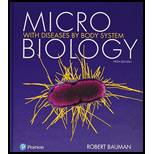
Microbiology with Diseases by Body System (5th Edition)
5th Edition
ISBN: 9780134477206
Author: Robert W. Bauman Ph.D.
Publisher: PEARSON
expand_more
expand_more
format_list_bulleted
Concept explainers
Question
Chapter 23, Problem 1VI
Summary Introduction
To answer:
To describe the events of tooth decay.
Introduction:
Tooth decay, also called as cavities, refers to the breakdown of the teeth due to the acids in the tooth surface made by the bacteria. The most common bacterium which causes tooth cavities is Streptococcus mutans.
Expert Solution & Answer
Want to see the full answer?
Check out a sample textbook solution
Students have asked these similar questions
What is the structure and function of Eukaryotic cells, including their organelles? How are Eukaryotic cells different than Prokaryotic cells, in terms of evolution which form of the cell might have came first? How do Eukaryotic cells become malignant (cancerous)?
What are the roles of DNA and proteins inside of the cell? What are the building blocks or molecular components of the DNA and proteins? How are proteins produced within the cell? What connection is there between DNA, proteins, and the cell cycle? What is the relationship between DNA, proteins, and Cancer?
Why cells go through various types of cell division and how eukaryotic cells control cell growth through the cell cycle control system?
Chapter 23 Solutions
Microbiology with Diseases by Body System (5th Edition)
Ch. 23 - Prob. 1TMWCh. 23 - Prob. 2TMWCh. 23 - Why is the elimination of sucrose sugar from the...Ch. 23 - Prob. 1CCSCh. 23 - The Case of the Lactovegetarians Two patientsa...Ch. 23 - Prob. 4TMWCh. 23 - Prob. 1EDCSCh. 23 - Why does the visually distinctive appearance of...Ch. 23 - Prob. 3CCSCh. 23 - Prob. 6TMW
Ch. 23 - Which of the following is not part of the...Ch. 23 - Prob. 2MCCh. 23 - Prob. 3MCCh. 23 - Prob. 4MCCh. 23 - Which of the following is a virulence factor...Ch. 23 - Prob. 6MCCh. 23 - Prob. 7MCCh. 23 - Prob. 8MCCh. 23 - Prob. 9MCCh. 23 - One of the more common waterborne gastrointestinal...Ch. 23 - Prob. 11MCCh. 23 - Prob. 12MCCh. 23 - Prob. 13MCCh. 23 - Prob. 14MCCh. 23 - Prob. 15MCCh. 23 - Prob. 1MTFCh. 23 - Prob. 2MTFCh. 23 - Prob. 3MTFCh. 23 - Prob. 4MTFCh. 23 - Prob. 5MTFCh. 23 - Prob. 6MTFCh. 23 - Prob. 7MTFCh. 23 - Prob. 8MTFCh. 23 - Prob. 9MTFCh. 23 - Prob. 10MTFCh. 23 - Prob. 1FIBCh. 23 - Prob. 2FIBCh. 23 - Fill in the Blanks 3. Peptic ulcers collectively...Ch. 23 - Prob. 4FIBCh. 23 - Prob. 5FIBCh. 23 - Fill in the Blanks 6. Swelling of the parotid...Ch. 23 - Prob. 7FIBCh. 23 - Fill in the Blanks 8. Discovering oval cysts that...Ch. 23 - Prob. 9FIBCh. 23 - Prob. 10FIBCh. 23 - Prob. 1MCh. 23 - What role does the normal microbiome play in...Ch. 23 - Prob. 2SACh. 23 - Prob. 3SACh. 23 - Prob. 4SACh. 23 - Prob. 5SACh. 23 - Prob. 6SACh. 23 - Prob. 7SACh. 23 - Prob. 8SACh. 23 - Prob. 9SACh. 23 - Prob. 10SACh. 23 - Prob. 1VICh. 23 - Prob. 2VICh. 23 - Prob. 1CTCh. 23 - Prob. 2CTCh. 23 - Prob. 3CTCh. 23 - Infections with HBV and HCV usually take years....Ch. 23 - Why did soldiers living in battlefield trenches in...Ch. 23 - Prob. 6CTCh. 23 - Prob. 7CTCh. 23 - Prob. 8CTCh. 23 - Prob. 9CTCh. 23 - Prob. 10CTCh. 23 - Prob. 11CTCh. 23 - Prob. 12CTCh. 23 - Why and when should parents have their children...Ch. 23 - Prob. 14CTCh. 23 - Using the following terms, complete this concept...
Knowledge Booster
Learn more about
Need a deep-dive on the concept behind this application? Look no further. Learn more about this topic, biology and related others by exploring similar questions and additional content below.Similar questions
- In one paragraph show how atoms and they're structure are related to the structure of dna and proteins. Talk about what atoms are. what they're made of, why chemical bonding is important to DNA?arrow_forwardWhat are the structure and properties of atoms and chemical bonds (especially how they relate to DNA and proteins).arrow_forwardThe Sentinel Cell: Nature’s Answer to Cancer?arrow_forward
- Molecular Biology Question You are working to characterize a novel protein in mice. Analysis shows that high levels of the primary transcript that codes for this protein are found in tissue from the brain, muscle, liver, and pancreas. However, an antibody that recognizes the C-terminal portion of the protein indicates that the protein is present in brain, muscle, and liver, but not in the pancreas. What is the most likely explanation for this result?arrow_forwardMolecular Biology Explain/discuss how “slow stop” and “quick/fast stop” mutants wereused to identify different protein involved in DNA replication in E. coli.arrow_forwardMolecular Biology Question A gene that codes for a protein was removed from a eukaryotic cell and inserted into a prokaryotic cell. Although the gene was successfully transcribed and translated, it produced a different protein than it produced in the eukaryotic cell. What is the most likely explanation?arrow_forward
- Molecular Biology LIST three characteristics of origins of replicationarrow_forwardMolecular Biology Question Please help. Thank you For E coli DNA polymerase III, give the structure and function of the b-clamp sub-complex. Describe how the structure of this sub-complex is important for it’s function.arrow_forwardMolecular Biology LIST three characteristics of DNA Polymerasesarrow_forward
arrow_back_ios
SEE MORE QUESTIONS
arrow_forward_ios
Recommended textbooks for you
 Human Physiology: From Cells to Systems (MindTap ...BiologyISBN:9781285866932Author:Lauralee SherwoodPublisher:Cengage Learning
Human Physiology: From Cells to Systems (MindTap ...BiologyISBN:9781285866932Author:Lauralee SherwoodPublisher:Cengage Learning- Health Safety And Nutrition F/Young ChildHealth & NutritionISBN:9781305144767Author:MAROTZPublisher:Cengage



Human Physiology: From Cells to Systems (MindTap ...
Biology
ISBN:9781285866932
Author:Lauralee Sherwood
Publisher:Cengage Learning


Health Safety And Nutrition F/Young Child
Health & Nutrition
ISBN:9781305144767
Author:MAROTZ
Publisher:Cengage

How stress affects your body - Sharon Horesh Bergquist; Author: TED-Ed;https://www.youtube.com/watch?v=v-t1Z5-oPtU;License: Standard Youtube License